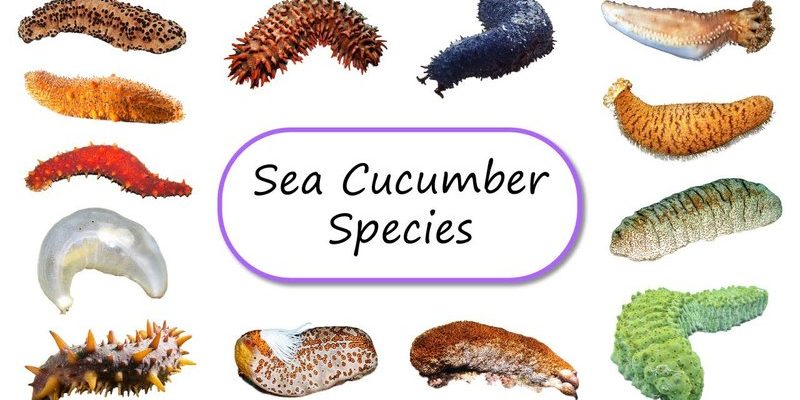![Sea Cucumber Vs. [Similar Species] - Key Differences](https://gudri.com/wp-content/uploads/2025/06/Sea_Cucumber_Vs___Similar_Species______Key_Differences_image_0.jpg)
So, what’s the deal with sea cucumbers and sea urchins? Picture a sea cucumber as the soft, squishy member of the ocean floor, while a sea urchin resembles a spiky ball just waiting to roll away. Both belong to the same phylum, Echinodermata, but they have distinct features and functions that reflect their lifestyles. Here’s a straightforward breakdown of their key differences.
Physical Appearance
When it comes to appearances, sea cucumbers and sea urchins couldn’t be more different.
Sea Cucumbers are elongated and, as the name suggests, have a soft, cucumber-like shape. Their bodies are often covered in small, fleshy tubercles that can vary in color—from deep blacks to stunning reds and greens. They usually measure from just a few inches to about three feet long, which is pretty impressive for something that mostly lies on the ocean floor.
In contrast, Sea Urchins are small, round creatures typically covered in long, sharp spines. Imagine a ball covered in tiny, spiky spikes. These spines can be colorful too, ranging from purple to green and even blue. You might also notice that sea urchins have a hard shell, or test, that protects their insides and gives them a distinctive shape.
Habitat and Behavior
Now, let’s chat about where these creatures hang out.
Sea Cucumbers are known to thrive in a variety of marine environments. You can find them in shallow waters, deep ocean floors, or even coral reefs. They love to burrow into the sand and mud, where they play a crucial role as scavengers. They feed on organic matter, helping to recycle nutrients back into the ecosystem, which is pretty important for maintaining ocean health.
On the other hand, Sea Urchins tend to favor rocky substrates, often clinging to surfaces like cliffs or coral reefs. They’re more mobile than sea cucumbers, using their thousands of tiny tube feet and spines to move about. Sea urchins are grazers, munching on algae and sometimes even coral. Their grazing habits can significantly influence the structure of their habitats, which means they can have a larger impact on their environment than you might expect.
Diet and Feeding Methods
Speaking of diets, here’s how these two differ in their feeding habits.
Sea Cucumbers have a unique way of eating. They use their tentacle-like structures, called tube feet, to capture food particles in the water. These foot-like structures act like straws, sucking in organic debris and microscopic plankton that drift by. It’s like having a built-in vacuum cleaner that helps clean up the ocean floor!
Conversely, Sea Urchins are more like nature’s lawnmowers. They have specialized mouthparts, called Aristotle’s lantern, that consist of teeth-like structures used to scrape algae off rocks. When you spot sea urchins, you might notice patches of bare rock nearby—thanks to their grazing habits. They can heavily impact the marine ecosystem by controlling algae populations, which is essential for maintaining balance among oceanic plants and animals.
Reproduction and Lifespan
Let’s talk about how these creatures bring new life into the world.
Sea Cucumbers have a fascinating method of reproduction. Most species are hermaphroditic, meaning they possess both male and female reproductive organs. They can either self-fertilize or cross-fertilize with others. During spawning seasons, they release sperm and eggs into the water, where fertilization occurs externally. The larvae then drift in the ocean before settling down to grow into adult cucumbers.
On the flip side, Sea Urchins generally have separate sexes and also reproduce by releasing eggs and sperm into the water. Their reproductive cycles are often synchronized to increase the likelihood of successful fertilization. Sea urchin larvae go through several stages before becoming adults, and their lifespan can range from 5 to 10 years, depending on the species.
Ecological Importance
You might be wondering why these organisms matter.
Sea Cucumbers are vital for their roles in nutrient cycling. By consuming detritus and organic matter, they help replenish the soil in their environments, allowing for a healthier ocean ecosystem. They also serve as food for various animals, like fish and sea turtles, linking them into the food web.
Sea Urchins, on the other hand, help control algae populations. Too many sea urchins can lead to overgrazing, which can devastate kelp forests and other marine habitats. However, when their populations are balanced, they contribute to a healthy marine environment, ensuring that underwater plants can thrive.
In the end, both sea cucumbers and sea urchins have unique features that make them essential players in ocean ecosystems. Understanding the differences between these two can not only help us appreciate their roles better but also remind us of the intricate web of life beneath the waves.
So next time you’re near the ocean, take a moment to think about these fascinating creatures and their importance. Whether you’re spotting a soft sea cucumber slowly moving across the sea floor or a spiky sea urchin clinging to a rock, remember how beautifully complex the marine world is. Every little creature has a role to play, and we’re just beginning to grasp the extent of their influence.

